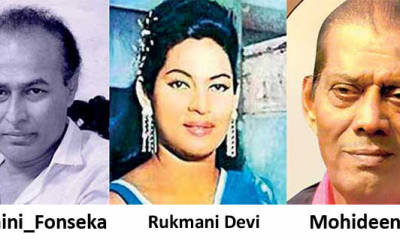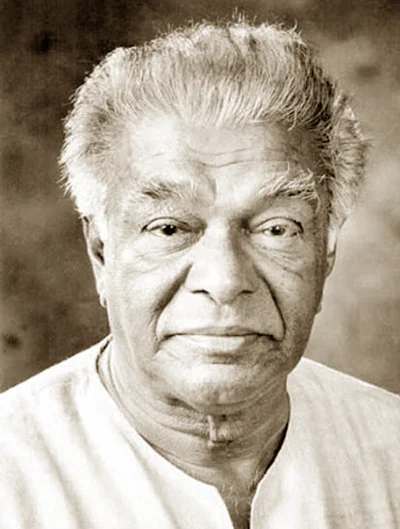Midweek Review
Dhamma Jagoda’s Vesmuhunu:
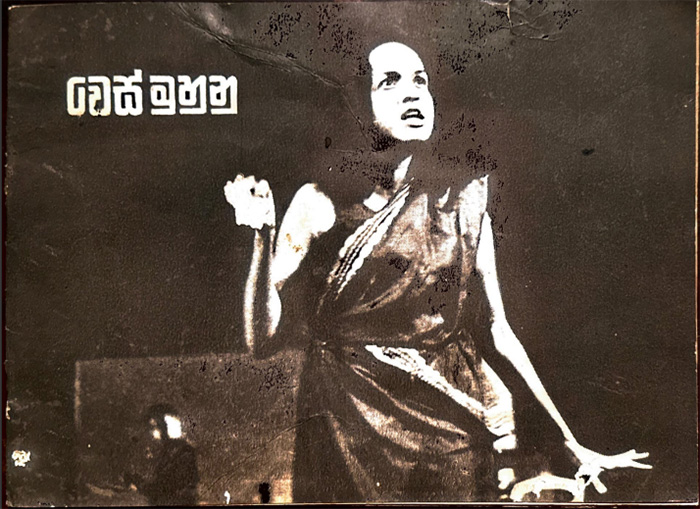
Irangani Serasinghe & Rukmani Devi’s Double-Act
By Laleen Jayamanne
A precious historical document was recently ‘unearthed’ by Ranjit, son of Irangani and Winston Serasinghe. It was a theatre programme for Dhamma Jagoda’s 1960s productions of Vesmuhunu (Masks), an adaptation of Tennessee Williams’ A Streetcar Named Desire. I don’t think I am being unduly melodramatic in referring to an ephemeral theatre programme as a ‘precious historical document’. Nor have I made a typo in referring to Jagoda’s ‘productions’, in the plural.
I am grateful to Ranjit Serasinghe for having kindly sent me a copy of this programme. It was indeed a most unusual document because there were details of three different productions of the play, with three different casts, in three different years, all directed by Dhamma Jagoda. And it was bilingual. In 1966, Jagoda’s Vesmuhunu was the only play performed at the Lumbini Theatre Festival, as the winner of the Arts Council’s Drama Competition that year. In that production Roma de Zoysa (a Colombo socialite and daughter of a former Finance Minister), played the main female role of Blanche Dubois the declasse Southern aristocratic lady who had lost her fortunes. In the play, she was presented as a Kandyan lady visiting her sister, who is married to a working-class man played by Dhamma and his own wife Sunethra Jagoda as his wife within the play.
According to the programme, Dhamma restaged Vesmuhunu in 1967 and 1968, in a manner that is worth remembering now, for historical reasons, after all those years. In 1967 the role of the aristocratic lady was played by Rukmani Devi, while in the 1968 production Irangani Serasinghe was chosen for it. Dhamma and Sunethra did not act in this last production, which saw film actors such as Wickrama Bogoda and Sriyani Amerasena join the cast.
Just recently I was reminded of these productions on hearing on Television A. D. Ranjit Kumara (a former editor of the Sarasawiya the weekly film tabloid), speaking of Rukmani Devi’s career. He spoke of Rukmani Devi’s immense sense of gratitude to Dhamma, for having given her the opportunity to perform in a reputable western play for the first time in her long career as a singer, film star and stage actor. He added that she bent down and worshipped Dhamma (a gesture of guru bhakthi), just before going on stage.
While listening to Kumara, I recalled that I had observed both Rukmani Devi and Irangani Serasinghe rehearse Vesmuhunu, but at a later date, perhaps in 1970, during the very early days of the Art Centre Theatre Workshop, which Dhamma directed with the support of Harold Peiris, a trustee of the Lionel Wendt Theatre. In those early days, before the theatre was renovated to house the workshops, Peiris had provided his large open portico with chairs for our theatre studies to be conducted in.
I remember these two actresses rehearsing the play with Dhamma in this very space, and also recall registering the very different timbre and texture of their most unusual, trained voices, as I think others also did. Now, I think that Dhamma was reviving the play he had already directed thrice in the 60s, for the fourth time, in the context of the Theatre Workshop. I left the country not long after and have no memory of a performance outcome, but do remember the workshop being interrupted by the insurrection of April 71. It’s not possible to verify details of a fourth production as Dhamma is long gone and people’s memories have faded away. The only way is for someone to search through the newspaper archives for reviews of the productions. But I wonder if there is sufficient interest to do that kind of arduous archival work, so as to even simply chronicle, at the very least, the 60s theatre. Perhaps, Hague Karunarathne’s Ludowyk Memorial Lecture has already done this, though I haven’t had access to it. If so, then detailed theoretical analyses can be developed by young scholars.
Ranjit Serasinghe mentioned to me that his father’s archive of papers on his parents’ acting careers await digitisation by someone interested in the field. Yet again, I feel that in another country these papers (like those of Siva Sivanandan’s on Lankan cinema), would now be safely in a specialist library accessible for research. Ranjit Kumara’s book on Rukmani Devi might lead the way, but that book too must be a collector’s item now.
Theatre Criticism
The Vesmuhunu programme had many gems. One was a concise but (as always) insightful piece by Regi Siriwardena in English, about the differences between a translation and an adaptation as it applied to Dhamma’s Vesmuhunu and more generally too. He tells us that a good adaptation imaginatively transposes an original context, into a milieu with a local resonance. He added that, in doing this, Dhamma had also improved on the original by deleting its ‘lumbering and creaking obtrusive symbolism’ and its ‘tracks of sentimentality,’ focusing on the human and social conflicts of the original which are its strengths. Knowing the original and Western drama well, Regi was able to make this sharp critical evaluation of how creative Dhamma’s adaptation was, adding that it is one of the few outstanding ones of its time.
The programme also contains a substantial discussion of Dhamma’s theatrical experiment by Vidyodaya academic Tissa Kariyawasam in Sinhala, a brilliant gem in its own right. He says that Dhamma had substantially changed his own version of the written play submitted to the drama competition, in his production for the stage. This observation highlights Dhamma’s theatrical talent as a director in staging emotional states, through physical theatrical action in space.
He makes the important point that the intelligentsia (viyathun), who never thought that Rukmani Devi was a gifted actor, now have the chance to see just how good she is. This evaluation is a profound one, coming from an academic, and he implies that it happened because of Dhamma’s own rare intuitive ability to be able to see it on his own and also act on it so decisively, creating theatre history. Thereby, he enabled Rukmani Devi to excel in a play with considerable cultural capital. Because this programme was made before Irangani’s version of the play was performed, we have no account of her performance and interpretation. But in choosing to have both actors perform the same role for a second time (perhaps in 1970), in close proximity, it’s clear that Dhamma considered both Rukmani Devi and Irangani Serasinghe to be excellent, unique actors, with very different styles of acting. The revealing art photographs in the 1968 program allow us a glimpse of these differences, which I will discuss below.
The quality of Regi and Tissa’s critical writing in the 60s and 70s is exemplary of that period of a bilingual, vibrant theatrical culture in the country, developed by director/writers such as Sarachchandra, Henry Jayasena, Sugathapala de Silva, Gunasena Galappatti, and others. I remember reading the reviews Regi wrote in English in those days and also listening, as a school girl, to the regular radio programme he presented called ‘Arts and Ideas’ which was packed with fascinating information. As a script writer for Lester James Peries and as a multi-lingual translator of poetry from several European languages, including Russian, he was especially interested in the problem of translation and transposition of foreign texts into a local context with its different histories and mores. As he wrote accessibly, and was interested in a philosophy of education, his reviews and talks unfailingly widened our knowledge. So, in this case, he offered T.S. Eliot’s ideas on translation and creative adaptation and also mentioned that Shakespeare and many others adapted pre-existing texts. Thereby making the point that creativity is to be found in the quality of the final product and the craft, no matter what the source.
Another important find in the programme was the existence of an institution called ‘The Young Artistes’ Cultural Organisation’, with Lester James Peries as its advisor, and the names of its members, including Aileen Sarachchandra, Sunethra Jagoda’s mother. We also learn that there was a ‘Drama Advisory Board’, of which Professor Sarachchandra was a member, with Cyril Wickramage as the secretary. This high level of support for Dhamma as a member of the Sarachchandra family would have been of great value to him in those early days. Tisse says that Dhamma’s Vesmuhunu was the only play chosen to be performed subsequently, implying a very high standard expected at the National Drama Festival as well. So, the programme provides a clear sense of a fertile theatrical culture, and also how theatrical institutions were created in the 60s to actively encourage daring theatrical experimentation, open to international trends and practices.
Photographic Documentation of Vesmuhunu
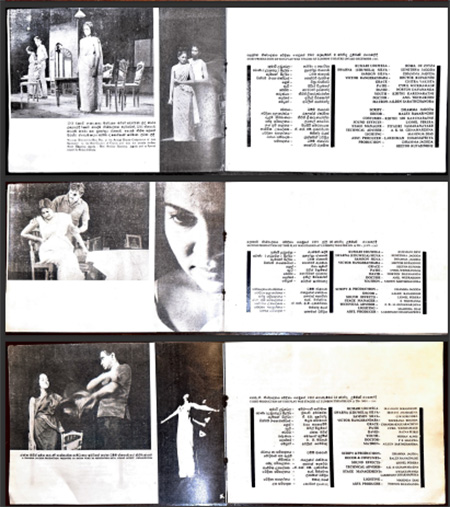
From the programme
There are a handful of black and white photographs of all three productions of Vesmuhunu included in the programme. As what I have is a copy of the original which itself is over fifty years old, the quality of the images is very poor but there are sufficient details there to be able to read the images for signs of the kind of interpretations Rukmani and Irangani brought to presenting their versions of the Kandyan lady, Kumari Uduwela. Of course, what one can do with a few unclear photographs is very limited and would remain as conjectures at best. But I feel I can do this because (though credit is not given), it is more than likely that the photos would have been taken by Ralex Ranasinghe who is credited for décor and costumes. The only exception is with the 1966 production, where while he did the Décor, the costumes were designed by the fashion designer Kirthi Sri Karunaratne who acted in the play and also ran a column on fashion in an English-language daily, in which Roma de Zoysa appeared quite often. So, this debut production of Dhamma’s had an unusual social mix as well.
Ralex Ranasinghe, Tony Ranasinghe’s brother, was a professional photographer, and it’s very likely that he took the photographs of all three productions. The wide shot of Roma de Zoysa shows a slender figure in a Kandyan sari with her hair piled on top in a bun.
The only photograph in the programme of Rukmani Devi is an extreme close-up of her face. It’s an art photograph, in which one half of her face is plunged into darkness, while the other half is lit. Furthermore, the face is angled in such a way that her head is slightly bent and she looks up with one eye; a veiled gaze. The expression of that eye is strong, and seductive. It’s the kind of gaze associated with what the French call a femme-fatale, the fatal woman who, according to her mythical attributes, will bring ruin to men through her mysterious sexuality. Rukmani’s dark eye make-up highlights this stylised framing of her face and the suggestion of mystery. She presents a familiar type in Western literature, film and image culture. Hollywood made a special genre of film, the Film Noir, with the femme-fatale as the main attraction and there were stars who were associated with playing that kind of role. Feminist film theorists have researched the long history of this seductive but destructive mythical female archetype, locating her within Western patriarchal narratives, including Eve who tempted Adam with an apple given to her by a devilish snake, leading to their expulsion from Paradise, according to the Bible.
In contrast to this seductive gaze of Rukmani’s, Irangani is shown in full size, smiling openly, dressed in white and dark Kandyan saris, with her hair unusually short falling to her shoulders. Her gestures are theatrically exuberant and outward looking. The feeling she projects is that of a light and airy creature. Though there is one of her looking very serious and troubled, seated at a table with her sister. But one can conjecture that Rukmani presented a dark and mysterious woman, while Irangani was mostly light and airy and fragile in her duplicity. That’s as far as one can go visually analysing and imagining with a few images. But the shot of Sunethra is altogether different, she is the realist figure, contained and constrained in her working-class environment by her husband, and in her role as pregnant wife.
So, the three women have very different characters and functions and acting styles, it would appear. I believe that Ralex Ranasinghe has captured these differences perceptively. Having also done the décor and costumes he would have had a very intimate, subtle knowledge of the texture of the image, materials, light and of the feelings they evoked.
Ralex Ranasinghe, as a professional photographer, had no doubt also seen some of Rukmani Devi’s star portraits of the 50s, at the height of her stardom. There are one or two black & white close-up studio photographs of her as a star, where she does not smile, and her eyes show a dark, languorous, mysterious quality, an eroticism, such as I have not seen in any other Lankan star photograph. In this, she is rather like Ava Gardner, a famous Hollywood femme fatale. I think, the artfully noirish close-up of Rukmani Devi in the program must have been done in a studio, where Ralex Ranasinghe would have been able to control light and shadow with precision, to plunge one half of Rukmani Devi’s face into a dark void. It’s a remarkable and rare film noir image, capturing a rarely seen emotional register, on the face of that incomparable star of the Sinhala cinema. A vesmuhuna like the dark side of the moon, one might say.
Imagine if some curious scholar did unearth the reviews of all the performances, what a treasure trove they would reveal to us about Dhamma Jagoda, Rukmani Devi and Irangani Serasinghe, in their unique visionary and, yes, daring collaboration in Vesmuhunu!
Tennessee Williams’ striking title, A Streetcar Named Desire, was based on an actual street car (bus), in New Orleans, leading to a suburb called Desire.
But ‘A Bus Named Desire’ would have been farcical. The Southern milieu was the racially mixed French quarter with Blues music in the background, heard between scene changes in the first production on Broadway, with Marlon Brando in the main role. Williams mixes the realist title with a poetic register, in the heady mix of sexual violence, class-based powerplay and fantasy.
Dhamma (from the Southern town of Hikkaduwa) would have grown up with a familiarity with masks and ritual performances indigenous to that area. So, when he also chose a poetic title, Vesmuhunu (Masks) for his adaptation, he is playing with many reverberations, including the idea of social masks. In so doing he appears to be able to widen the formal possibilities of realist drama of the ‘lower depths,’ by also presenting ‘social types’, which in their abstraction, are mask-like. For this kind of experimentation, with different types of characterisation and ideas of character, and different registers of acting for each, Dhamma needed experienced actors with great reserves of talent, precise training, a depth of experience, and a desire to take risks, all of which he found in Rukmani Devi and Irangani Serasinghe at the height of their maturity.
It is around this time that Dhamma also produced Dharmasena Pathiraja’s brilliant one act absurdist play, Kora saha Andaya (The Lame man and the Blind) in a sparse, minimalist staging of remarkable intensity. It appears that Dhamma directed this play after he had returned from a research trip to both Britain and the Lee Strasberg Actors’ Studio in New York, to observe different theatrical traditions. Through their collaboration, Pathiraja and Dhamma created two mutually dependent human and social types, a blind man and a lame man. One carrying the other on his shoulder, the other leading the way, binding them into one composite figure, seeking a promised land in an existential void. The long wooden pole which supported them was the only prop, used in unimaginable ways, also to produce sounds on a bare wooden stage, sculpted with light, on which Wimal Kumar de Costa and Daya Pathirana gave unforgettable performances.
Marlon Brando had trained with Lee Strasberg and is credited with inventing a new, understated, internalised kind of masculine acting: Method Acting. It was Brando’s brutish role of Stanley Kowalski that Dhamma played in his own production of Vesmuhunu. One wonders if Dhamma left any research notes on his trip abroad and if he had seen the film of the play with Brando and Vivien Leigh, screened in Colombo in the early 50s. Despite his electrifying and award-winning performance, Dhamma did choose to focus on directing rather than on becoming Lanka’s answer to Marlon Brando.
This was indeed a lucky choice for the development of Lankan theatre. Dhamma’s foresight as an educator, in developing a Drama Curriculum for the schools, was also a major contribution to Lankan theatre.
Midweek Review
How Prof. Dewasiri’s FB post brought about Speaker Ranwala’s exit
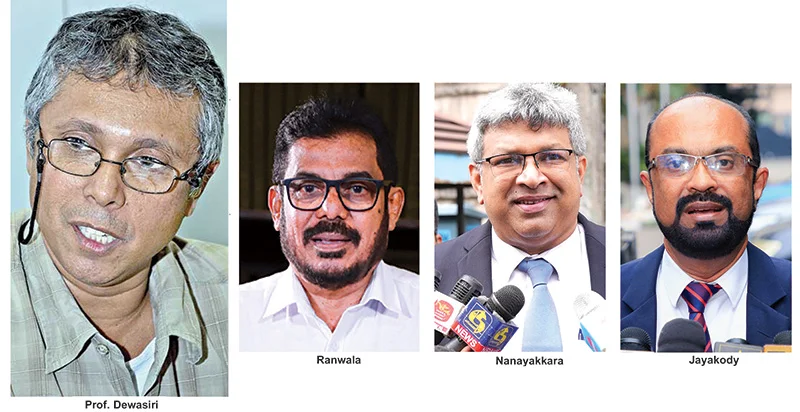
By Shamindra Ferdinando
Prof. Nirmal Ranjith Dewasiri was the first to question the National People’s Power government over Speaker ‘Dr.’ Asoka Sapumal Ranwala regarding his academic qualifications.
Dewasiri’s shock query caught the NPP by surprise. The academic questioned the government on his social media account on 05 Dec. The Parliament unanimously appointed Ranwala as Speaker of the Tenth Parliament on 21 Nov.
Dewasiri demanded that the government compel Speaker Ranwala to resign in case the parliamentarian deliberately provided false information. If the Speaker declined to do so, appropriate measures should be taken to remove him, Prof. Dewasiri declared, while finding fault with the new entrant for (i) falsely claiming to have a degree and (ii) believe he could hold such an important position regardless of the deceit perpetrated by him.
Prof. Dewasiri emphasized that the second fault was far worse than the first. One-time spokesperson for the Federation of University Teachers Association (FUTA) and advocate of the Yahapalana administration warned the government of far reaching consequences as it was badly exposed.
The government obviously didn’t take Prof. Dewasiri’s social media post seriously. Perhaps the top leadership felt that the issue at hand wouldn’t attract much public attention. However, the Opposition, both in Parliament and outside, launched an all-out attack.
The SJB declared its intention to move a no-confidence motion against the Speaker. In spite of the NPP having an unprecedented 2/3 majority in Parliament, the ruling party feared to face the Opposition move. The NPP could have easily routed the combined Opposition in Parliament, but to defend an obvious wrongdoer would have ruined President Anura Kumara Dissanayake’s (AKD) parliamentary group as they came to power, less than three months ago, promising to correct all the shenanigans that had been going on in the country, under the guise of democracy, since independence.
Beleaguered AKD had no option but to ask Speaker Ranwala to step down. The NPP could have avoided a lot of flak if the party acted immediately after Prof. Dewasiri’s disclosure. If not for the intervention made by the academic and a vociferous critic of wrongs done by the previous regimes, particularly to academics, Ranwala would still have been the Speaker.
The utterly dispirited SJB wouldn’t have inquired into Ranwala’s credentials under any circumstances. Thanks to Prof. Dewasiri, the Opposition received a mega opportunity to question the very basis of the NPP’s presidential and parliamentary election campaigns.
The SJB and new Democratic Front (NDF) had been rejected by the electorate to such an extent, even if they challenged Ranwala over his educational qualifications, the people may have ignored the issue as the rantings of a frustrated Opposition still licking the wounds of their routing at the polls. Prof. Dewasiri’s disclosure obviously delivered a knockout blow to the government.
Ranwala resigned on 13 Dec., just over a week after Prof. Dewasiri’s bombshell revelation. It would be pertinent to mention that just before the announcemnt of the Speaker’s resignation, President AKD told government media bosses that he wouldn’t protect any wrongdoer.
Having asked the electorate to reject unscrupulous political parties that had ruined the country, the NPP couldn’t have risked its political project to save Ranwala, one-time President of the Ceylon Petroleum Common Workers’ Union, until he was sent on compulsory retirement in March 2023 by the then Minister of Power and Energy Kanchana Wijesekera. The Wickremesinghe-Rajapaksa government accused Ranwala of obstructing fuel distribution services.
The NPP couldn’t have been unaware of Ranwala’s bogus claim. If Ranwala deliberately deceived the NPP, he should be dealt with harshly. Perhaps Ranwala should be asked to resign his parliamentary seat forthwith for deceiving the whole country, to pave the way for the NPP to fill that Gampaha District vacancy thereafter. Having vowed to clean up Parliament, the NPP cannot, under any circumstances, protect any wrongdoer.
But, corrupt political parties shouldn’t think for a moment that they can capitalize on the Speaker’s issue. The people rejected the SJB, NDF and SLPP (Sri Lanka Podujana Peramuna) twice this year as they earned the wrath of the people. It would be a grave fault on their part if they believed Ranwala’s ouster could strengthen their campaign against the government.
The NPP should, without delay, set the record straight. The issue is whether Ranwala deceived the NPP with regard to his doctorate, or the party knew all along that their CPC trade unionist didn’t have the academic qualification which he proudly flaunted.
House tricked
Premier Dr. Harini Amarasuriya and Foreign Minister Vijitha Herath, together, accompanied Ranwela to the Speaker’s chair. The Opposition accepted the appointment. The Premier proposed Ranwala, while Minister Herath seconded that proposal.
Premier Amarasuriya, Opposition Leader Sajith Premadasa, and Leader of the Sri Lanka Muslim Congress Rauff Hakeem congratulated National Executive Committee member Ranwala on that occasion.
One-time member of the Biyagama Local government body, Ranwala twice represented the JVP in the Western Provincial Council. According to Parliament website, Ranwala holds a degree in Chemical Engineering from the University of Moratuwa and a doctorate in Biochemistry from Waseda University, Japan.
To make matters worse for the NPP, the Opposition challenged Deputy Speaker Dr. Rizvie Salih’s specialist tag. Salih answered his critics. His FB post explained his nearly 40-year career, with 12 years with the public sector, though he is not a specialist.
The Deputy Speaker told Parliament, on Tuesday, that he is not a specialist and never used the title in his official letterheads, visiting cards and prescriptions. ” I have categorically told that I should not be called a specialist in propaganda material during elections,” he said. In other words, he had found fault with those who handled the propaganda campaign for the NPP
Interested parties also challenged the doctorate of Justice Minister Harshana Nanayakkara, another first time entrant to Parliament.
The controversy over Nanayakkara’s doctorate took an unexpected turn when the Parliament claimed that the doctorate had been inadvertently mentioned by Parliament. Let me reproduce the clarification issued by M. Jayalath Perera, Director Legislative Services / Director Communication (Acting), Parliament: Clarification Regarding the Title of “Dr.” mentioned before the name of the Minister of Justice, Attorney-at-Law, Hon. Harshana Nanayakkara, on the Parliament website.
“I would like to emphasize the following points in relation to reports published in the media regarding the title of ‘’Dr.’’ mentioned before the name of the Minister of Justice and National Integration, Attorney-at-Law, Harshana Nanayakkara, in the directory of Members of Parliament on the Parliament website.
“It is important to note that Hon. Harshana Nanayakkara has not indicated holding a doctoral degree in the information provided to Parliament. The appearance of the title “Dr.” before the Minister’s name was a result of an error in entering the relevant data. Accordingly, steps have been taken to rectify this mistake.
“I express my deepest regret for the inconvenience caused to the Minister of Justice and National Integration, Attorney-at-Law, Hon. Harshana Nanayakkara, in this regard.
“Also, the process of re-checking and updating the information of all Members of Parliament on the Parliament website is currently underway.”
But those who cannot stomach the NPP’s victory ask why didn’t Nanayakkara get that corrected himself if he was not entitled to be called “Dr.”? However, the Justice Minister lodged a complaint with the CID on Monday (16). The investigation can help ascertain whether some interested party conspired to discredit the NPP.
That clarification issued by Parliament meant that Ranwala provided false information to Parliament. According to Jayalath Perera, the parliamentary staff entered the relevant data provided by lawmakers, hence the only mistake on their part pertained to the Justice Minister’s data.
Power Minister Kumara Jayakody, too, lodged a complaint with police seeking an investigation into what he called an organized attempt to discredit him by challenging his academic qualifications. Both Nanayakkara and Jayakody speculated about the possibility of those who had been rejected by the people and their associates and supporters being involved in the high profile campaign.
The NPP cannot afford to disappoint 5.7 mn people who voted for AKD at the presidential election and 6.8 mn at the general election. The NPP increased its voter tally from 5.7 mn to 6.8 mn within a couple of weeks whereas the SJB was reduced to 1.9 mn votes from 4.3 mn at the presidential poll. The NDF was reduced to just 500,000 votes from 2.2mn at the presidential election while the SLPP increased its tally from 340,000 to 350,000. The Opposition is in disarray and in a pathetic situation.
Ranwala’s fiasco has sort of given the Opposition false hopes of a quick comeback. The forthcoming local government polls will show the ground situation. The NPP must keep in mind that in addition to the Ranwala affair, the failure on its part to provide sufficient relief to fuel and electricity consumers as promised has caused much public anger. Having repeatedly alleged that the previous government couldn’t substantially reduce fuel prices as the then Minister Kanchana Wijesekera pocketed the money, and having made those claims against the previous Minister in charge of the subject, the NPP brought down the price of a litre of Octane 92 by just 2 rupees much to the public’s resentment.
The pathetic handling of the rice mafia, too, didn’t do the NPP any good. Throughout the polls campaigns, the NPP repeatedly assured that the rice mafia would be appropriately dealt with and prices brought down and stabilized. The NPP also promised that rice wouldn’t be imported at all though imports would meet the tourist sector requirement. That much touted promise, too, was broken. However, the electorate, the writer is certain, doesn’t see any point in once again pinning their hopes on the utterly corrupt and dishonest lot rejected at the presidential and parliamentary polls.
Why Parliament shouldn’t defend wrongdoers
During the general election campaign, AKD explained why Parliament shouldn’t protect wrongdoers. The President said that the Yahapalana Parliament (2015-2019), during Karu Jayasuriya’s tenure as the Speaker, defeated a no-confidence motion moved against Ravi Karunanayake over the Treasury bond scams, especially after he told the Presidential Commission of Inquiry that probed it, he could not remember the person who gave him a luxury penthouse at Kollupitiya. Then in 2023 the Wickremesinghe-Rajapaksa government defended Keheliya Rambukwella when a no-faith motion was moved against him over corruption in the health sector procurement, the President said.
Having said so, AKD couldn’t have defended Ranwala in case the SJB handed over a no-confidence motion against him. In fact, the NPP has created an environment that may prevent those exercising political power from coming to the rescue of wrongdoers under any circumstances.
During Ranwala’s very short stint as the Speaker, he had the opportunity to receive several foreign dignitaries. Press releases issued by Parliament following those meetings referred to Ranwala as Dr. Ranwala.
South Korean Ambassador Miyon Lee paid a courtesy call on Speaker Ranwala on 04 Dec. at the Parliament complex. Secretary General of the Parliament Mrs. Kushani Rohanadeera, was also present on the occasion. This happened the day before Prof. Dewasiri exposed the NPP parliamentarian.
Ranwala, not aware of what was coming, addressed the newly elected members on 25 Nov., in Parliament, where he emphasized the responsibility on the part of newcomers (he, too, was a newcomer struggling to handle responsibilities for want of parliamentary experience) to familiarize with parliamentary procedures. Speaker Ranwala said that public expectations couldn’t be met unless they learnt about parliamentary procedures. Ranwala was addressing the inaugural session of the orientation programme for lawmakers.
The Parliament website quoted Speaker Ranwala as having emphasized the importance of organizing such workshops, noting that a thorough understanding of parliamentary traditions, constitutional frameworks, standing orders, and related parliamentary procedures is crucial for serving the people through the diverse debates conducted within Parliament.
Chinese Ambassador in Colombo Ambassador Qi Zhenhong was the first envoy to pay a courtesy call on Ranwala at the Parliament. The Chinese Ambassador conveyed the greetings of the Chairman of the Standing Committee of the National People’s Congress of the People’s Republic of China (Speaker of the Parliament of the People’s Republic of China) Zhao Leji, to the newly elected Speaker of the Tenth Parliament during the meeting.
The Chinese envoy was followed by Indian High Commissioner Santosh Jha. Jha paid a courtesy call on the Speaker on 28 Nov. at the Parliament.
The United Nations Resident Coordinator in Sri Lanka, Marc-André Franche, met Speaker Ranwala on 04 Dec.
In the wake of Prof. Dewasiri’s shocking disclosure, Speaker Ranwala received a high-level US delegation led by Assistant Secretary of State for the Bureau of South and Central Asian Affairs Donald Lu. The meeting took place on 06 Dec.
The delegation included Ms. Anjali Kaur, Deputy Assistant Administrator of the Bureau for Asia at USAID, and Mr. Robert Kaproth, Deputy Assistant Secretary for Asia at the US Department of the Treasury.
According to a press release issued by Parliament the meeting focused on Sri Lanka’s reform priorities and the critical role of the House in advancing the people’s mandate for accountability, transparency, and inclusive governance.
Ambassador of the United Arab Emirates to Sri Lanka Khaled Nasser AlAmeri was the next to pay a courtesy call on Speaker Ranwala. That meeting took place on 09 Dec. amidst a stepped-up campaign against Speaker Ranwala. The NPP seems to have operated on the premise that the controversy over the Speaker’s credentials would gradually fade away. But, the media pressed the Cabinet spokesperson Dr. Nalinda Jayatissa over the simmering serious issue. That controversy sort of overwhelmed the NPP that worked so hard to portray all other political parties, other than them, as corrupt to the core.
In fact, the NPP had nothing else but to depend on what it called a new clean political culture. Having impressed the electorate with nothing but promises and assurances that it would do the right thing, it couldn’t have a blatant liar as the Speaker.
If not for the political culture that had been introduced by the NPP, in the wake of Aragalaya in 2022, the false declaration made by Ranwala wouldn’t have been an issue at all. The people would have simply accepted it as just another lie. Our inefficient and useless Parliament had been so disgraceful in its conduct and encouraged public resentment that a Speaker’s false claim wouldn’t have caused a public furore.
The NPP’s failed bid to storm Parliament during the final push against President Gotabaya Rajapaksa should be examined taking into consideration the pathetic state of our Parliament. Some of those unscrupulous men who represented Parliament over the past two to three decades brought about the Parliament’s collapse. Instead of taking remedial measures, political parties allowed the deterioration to continue, unabated. Nothing can be as ridiculous as conducting student parliaments all over the provinces. What the Parliament really expected to achieve by promoting student parliaments at a time the very basis of the parliamentary system is under threat due to overall failure of the political party system.
Parliament must take appropriate measures to restore public confidence in the highest institution in the country. Ranwala’s affair proved beyond doubt that the Speaker, who is also the Chairman of the Constitutional Council, could manipulate the system. No one and no political party should be above the law. War-winning Sri Lanka had suffered unbearable losses for want of proper parliamentary control over public finance over the years.
Let us hope the NPP has learnt a hard lesson at the onset of AKD’s five-year term that would help the party to navigate choppy waters. The daunting challenges faced by a bankrupt country should prompt all political parties, represented in Parliament, to reach consensus on Sri Lanka’s response to the deal with the IMF, signed by Ranil Wickremesinghe. The issue the Parliament must grapple with is how to transform the sick national economy to make it possible for us to start repaying foreign debt in 2028 without making most of us absolute paupers, but many Lankans are already in dire straits economically.
The Parliament can begin by making the Supreme Court judgment on the economic crisis that led to Gotabaya Rajapaksa’s removal available to new members of Parliament. Of the 225 MPs, 162 are new entrants. The Supreme Court in Nov. 2023 issued a symbolic ruling that Rajapaksa brothers – including two ex-Presidents – were guilty of triggering the worst financial crisis by mishandling the economy.
In a majority verdict on multiple petitions filed by academics and civil rights activists, a five-judge bench of the Supreme Court ruled that the respondents, who all later resigned or were sacked, had violated public trust. But that verdict should be examined along with massive foreign loans taken by the Yahapalana government during the 2015-2019 period at high interests that contributed massively to the crisis.
Let there be no holds barred examination of the economic crisis and exposure of all responsible, regardless of their status. However, that wouldn’t be a reality unless the legislature fulfils its basic obligations in terms of the Constitution.
Let us also not lose sight of hidden hands, especially from the West who make matters worse through their cloak and dagger operations worldwide as also was put into operation here during Gotabaya Rajapaksa presidency, like even cutting off worker remittances from our banking system thereby we couldn’t even scrape together a few million dollars to clear even a shipment of cooking gas. They have done similar jugglery to so many other countries, even in our neighbourhood, as has been the case already in Bangladesh and Pakistan. Modi should not feel all that smug as we do not know what plots are being hatched against him.
Remember the uncompromising Aragalaya activists who were threatening to die for a system change in the country, but disappeared into thin air no sooner Ranil Wickremesimnghe was installed in the seat of power with the ouster of Gotabaya Rajapaksa by extra parliamentary means.
Midweek Review
Seeking cultural transmission between bodies
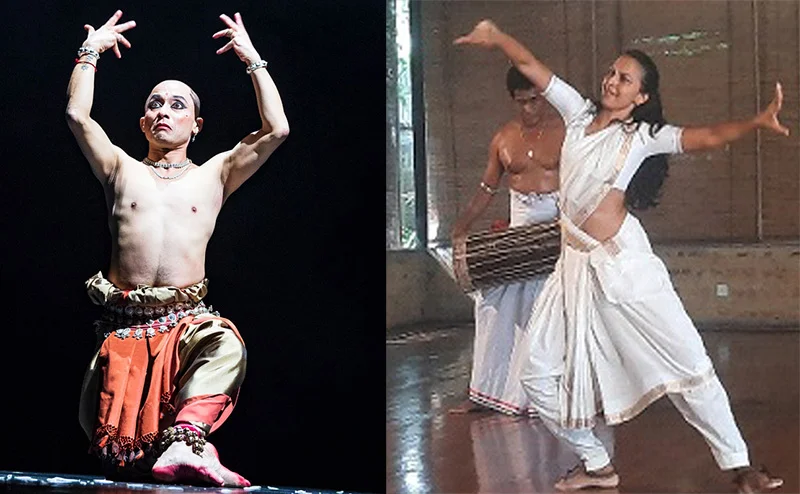
From Chitrasena to Akram Khan:
by Saumya Liyanage
Akram Khan is a world-renowned dancer, choreographer and the founder of Akram Khan Company (AKC) in the UK. He has been an impactful dancer and choreographer who was initially trained as a Kathak dancer during his apprenticeship under various Kathak Gurus in Asia and elsewhere. He and his dance company have created numerous dance productions that surpass the traditional boundaries. Akram Khan is a recipient of top awards including two Laurence Olivier Awards, the Bessie Award (New York Dance and Performance Award), the prestigious ISPA (International Society for the Performing Arts) Distinguished Artist Award, the Fred and Adele Astaire Award, the Herald Archangel Award at the Edinburgh International Festival, the South Bank Sky Arts Award, and ten Critics’ Circle National Dance Awards for his company.
With the initiative of the British Council in Colombo, the Akram Khan Dance Company contacted me a few months ago. The Legacy International Project Manager of the AKC, Varsha Kumar sent me an email informing me of an exciting project the dance company wanted to initiate in Jaffna. It was an upcoming collaboration between Akram Khan Company supported by the British Council Colombo to conduct an intense dance exchange workshop. This initiative facilitated a five-day intensive cultural transmission of Bharatanatyam dance conducted by Mavin Khoo, the artistic associate of the Akram Khan Company with a selected group of youth from Jaffna.
The idea was to continue and sustain the traditional dance forms and explore how they could be sustained and continued further through innovative practices. Mavin Khoo visited Jaffna for the first time to initiate this cultural transmission project with the hope of conducting this intense workshop on Bharatanatyam. Mavin Khoo, trained as a traditional dancer in Bharatanatyam in Malaysia, is a choreographer and the creative collaborator of Akram Khan. Mavin holds an MA in Choreography from Middlesex University and was a faculty member of the Dance Studies Department, School of Performing Arts at the University of Malta in 2014. He has been working as the rehearsal director of the Akram Khan Company and is exploring traditional dance and its contemporary relevance as a mode of human agency and provocation.
It is an ongoing work that the AKC initiated and this collaboration will continue further in future. Here is something interesting about what happened when Khoo, Varsha and their team came to Colombo after finishing the Jaffna Classical Intensive project. The British council director Edward Orlando invited me to a networking lunch in Colombo, where Khoo and Varsha were present. At lunch, I met some of the Sri Lankan dance community representatives. They included versatile dancers such as Upeka Chitrasena, Heshma Wignaraja, and Kapila Palihawadana. We shared our thoughts and ideas about dance and future collaborations during lunch. After this session, Upeka Chitrasena invited us to visit Chitrasena Dance Company. Akram Khan Company focused on helping peripheral dance groups to sustain and continue their traditional dance heritage and encouraged them to expand their possibilities of innovations, and the Chitrasena Dance Company in Colombo is also dedicated to preserving and continuing Sri Lankan traditional dance practices for posterity.
Dance as Ekstasis
- Chitrasena (1921-2005)
- Akram Khan
I am not a dancer, but I have been interested in dance and dance theatre throughout my academic career. Dance and theatre share many elements and it is the body that is central to the dancer and actor’s work. A few days ago, at the Faculty of Medicine, a session was conducted by the Centre for Meditation Research on how movement facilitates happiness and wellbeing. With my research collaborators, Kanchana Malshani and Chamanee Darshika, I demonstrated how movement is central to our understanding of the self and the world. The key question that I posed at the seminar is that movement allows us to understand our body, time and space and allows us to understand how we could connect with other bodies. Movement is the primal element of the body of the animated being.
What fascinates me here is that actor/dancer experiences time and space and the Other, in a different way than we experience the same phenomena on the daily basis. Dance scholar and Philosopher Sheets Maxine-Johnston argues that Man comprises temporality within himself, for he is such an ekstatic being. He is always at a distance of himself, always in flight” (Sheets-Johnston, 2015, pp. 16-17). This statement clearly indicates how the dance and dance experience override the objective time and space. Greek etymology of the word ekstatic means how one emancipates from her/his own self and transcends for the daily reality. In this sense, the moving body of the dancer, as I witnessed at the Chitrasena Dance Company, shows that dancers’ “being” is not in the daily reality when they intensely move their bodies in the space and time with the complex drum ensemble. Hence, I argue that our understanding about time and space is constructed through the physiological and mathematical understanding of time and space. The other is understood in a way that we as selves are constructed and defined through various lingual and cultural discourses. In this sense, the dancer/actor surpasses these constructed boundaries when the body becomes animated through dance and acting.
We sat at the Chitrasena Dance Company in the afternoon of Dec., 14 2024, and Khoo and Varsha were scheduled to leave Colombo a few hours later. An intense and galvanising performance was unveiled at the bare stage of Chitrasena Dance Company with Thaji Dias and the dance ensemble with seven master drum players. One after the other, a series of traditional dance repertoires unfolded before our eyes. Particularly Thaji Dias’ mesmerising and electrifying bodily motility of Kandyan, Low Country and Sabaragamuwa styles blended with intense rigor and precision. It was evident that some of the dance repertoires that Thaji and the lead male dancer performed were somewhat improvisational, bringing key elements of Kandyan dance into an ecstasy of performance. Both dancers seemed to be connected with each other through somatic means, communicating with facial and bodily gestures to trigger certain dance repertoire to perform together. I witnessed that both dancers were kinesthetically and sensorially joined through learned repertoires to perform a new interpretation of Kandyan dance form.
Cultural Transmission
These traditional dance performances triggered several important questions related to the dance body and cultural transmission of somatic knowledge. First, when Heshma, the artistic director and choreographer of Chitrasena Dance Company introduced a particular dance repertoire developed and choreographed by Vajira Chitrasena, she articulated this as a cultural transmission of choreographic knowledge which came through two generations of dancers. This statement triggered several important questions related to dance historiography. When Chitrasena and Vajira choreographed their works, it may have been done through the embodied knowledge that they possessed through what they learnt and mastered from the traditional Gurus. However, Chitrasena and Vijira may have understood that replicating traditional dance and its repertoire would not add any innovation to their dance interventions. My interest was drawn to this phenomenon and the question emerged on how these individual dance artists have distilled the traditional Kandyan dance to modernist choreographic works through adding innovative elements to their newly founded body notations.
Researchers who are working on the intangible cultural heritage mainly focus on how traditional dance and heritage can be transmitted. They are mainly concerned about how these traditions are continued and sustained through contemporary dance ensembles. However, the intangible heritage discourse has least focused on how these dance traditions have been changing through time and how these new elemental changes have been transformed and transmitted to the next generation of dancers. During our encounters with dance choreographer and artistic director of Chitrasena Dance Company, Heshma discussed how they “do” dance. Her articulation of “doing” dance rather than talking about dance explains how they transmit knowledge of somatic elements of dance through bodies. She said, “We rarely talk … we do not use language but we do dance”. One of the challenges posed by these issues is that the corporeal learning and embodied knowledge cannot be objectified in the researcher’s eyes. They are somatically embedded in the dancers’ bodies and are sedimented within their dance repertoires. A meticulous observation, analysis and categorisation will be required for someone to understand and identify how these dance elements have been changed and embedded in the dancer’s body. As I believe, new dance ethnographic research would be useful for researchers to extricate those elemental dance repertoires to understand how contemporary dancers’ bodies embody dance heritage in their somatic memories.
Conclusion
Akram Khan and his creative associate Mavin Khoo explore the possibilities of preserving traditional dance forms while seeking opportunities to revive them through innovative practices. The Chitrasena Dance Company working in the field of traditional Sri Lankan dance ambitiously is in search of a new era of Sri Lankan dance while passing the Chitrasena -Vajira dance heritage to the next generation of dancers and choreographers. Both companies share similar objectives in dance preservation and innovations within the highly contested Global cultural domains. Khan, Khoo, Chitrasena, Vajira, Thaji and other dancers embody a vast knowledge of somatic practices akin to their own dance traditions. Yet, these ekstatic bodies transcend the daily constructed selves, which carry the somatic knowledge of dance that are waiting to be disseminated in the bodies of the next generation of dancers. These areas of dance-ethnography should be further developed to understand the embodied knowledge and the somatic practices infiltrated through the generations of dancers and drummers. New dance-ethnography, dance historiography and new methodologies should be developed and applied to deepen our understanding of dance as an explicit knowledge of human expressions, emotions and ecstasy.
References
Sheets-Johnston, M. (2015). The phenomenology of dance. Philadelphia (Pensilvania, Estados Unidos) Temple University Press.
Company, Akram Khan. n.d. “Our Biographies.” Akram Khan Company. Cog. Accessed 2024. https://www.akramkhancompany.net/about-us/our-biographies/.
Company, Akram Khan. n.d. “Our Biographies.” Akram Khan Company. Cog. Accessed 2024. https://www.akramkhancompany.net/about-us/our-biographies/.
Nürnberger, Marianne. 2014. “Vajira – the First Professional Female Dancer of the Sinhalese Style.” Sri Lanka Journal of Humanities 40 (0): 99. https://doi.org/10.4038/sljh.v40i0.7232.
Raheem, Mirak. 2022. “Vajira: The Pioneering Female Dancer.” South Asian Dance Intersections 1 (1). https://doi.org/10.55370/sadi.v1i1.1475.
–––
Saumya Liyanage is an actor and professor in Drama and Theatre, currently working at the Department of Theatre Ballet and Modern Dance, Faculty of Dance and Drama, University of Visual and Performing Arts, Colombo, Sri Lanka. saumya.l@vpa.ac.lk
The author wishes to thank Himansi Dehigama for her assistance in preparing this article.
Midweek Review
Motherhood Triumphs
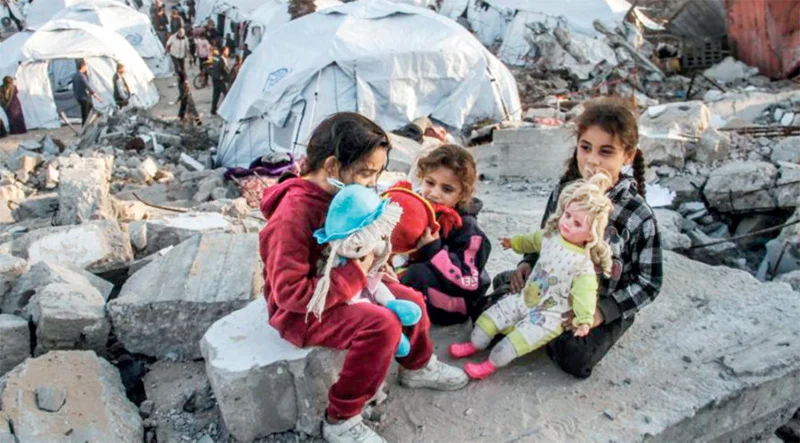
By Lynn Ockersz
Out of war’s destructive wastes,
And piles of mortal remains,
There emerge buds of promise,
Hardly into their teenage years,
That radiate childhood innocence,
And a motherhood of selflessness,
That would give fragile humans,
Their only security guarantee,
In a life rifled with uncertainties.
-
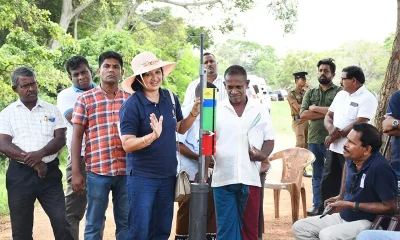
 News6 days ago
News6 days agoInnovative water management techniques revolutionising paddy cultivation in Lanka
-
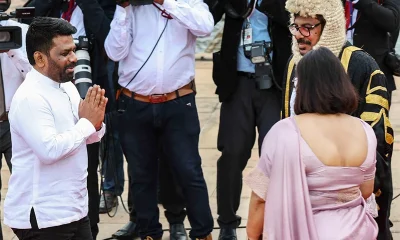
 Features5 days ago
Features5 days agoThe Degree Circus
-
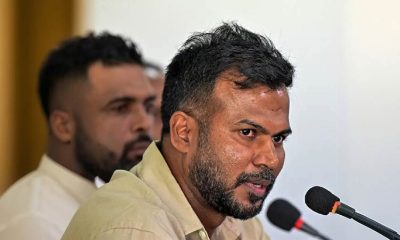
 Sports3 days ago
Sports3 days agoSri Lanka to mend fences with veterans
-

 Opinion5 days ago
Opinion5 days agoHas ‘Compass’ lost direction?
-

 Editorial6 days ago
Editorial6 days agoA supreme irony
-

 Sports1 day ago
Sports1 day agoPathirana set to sling his way into Kiwi hearts
-
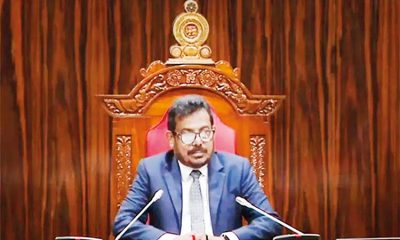
 Opinion6 days ago
Opinion6 days agoDocs, Speakers and Profs
-
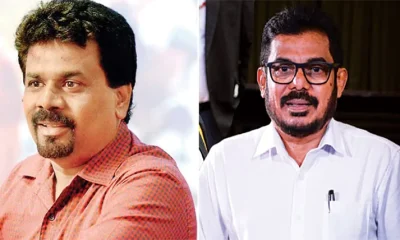
 Features6 days ago
Features6 days agoGovt.’s anti-corruption agenda gets boost


